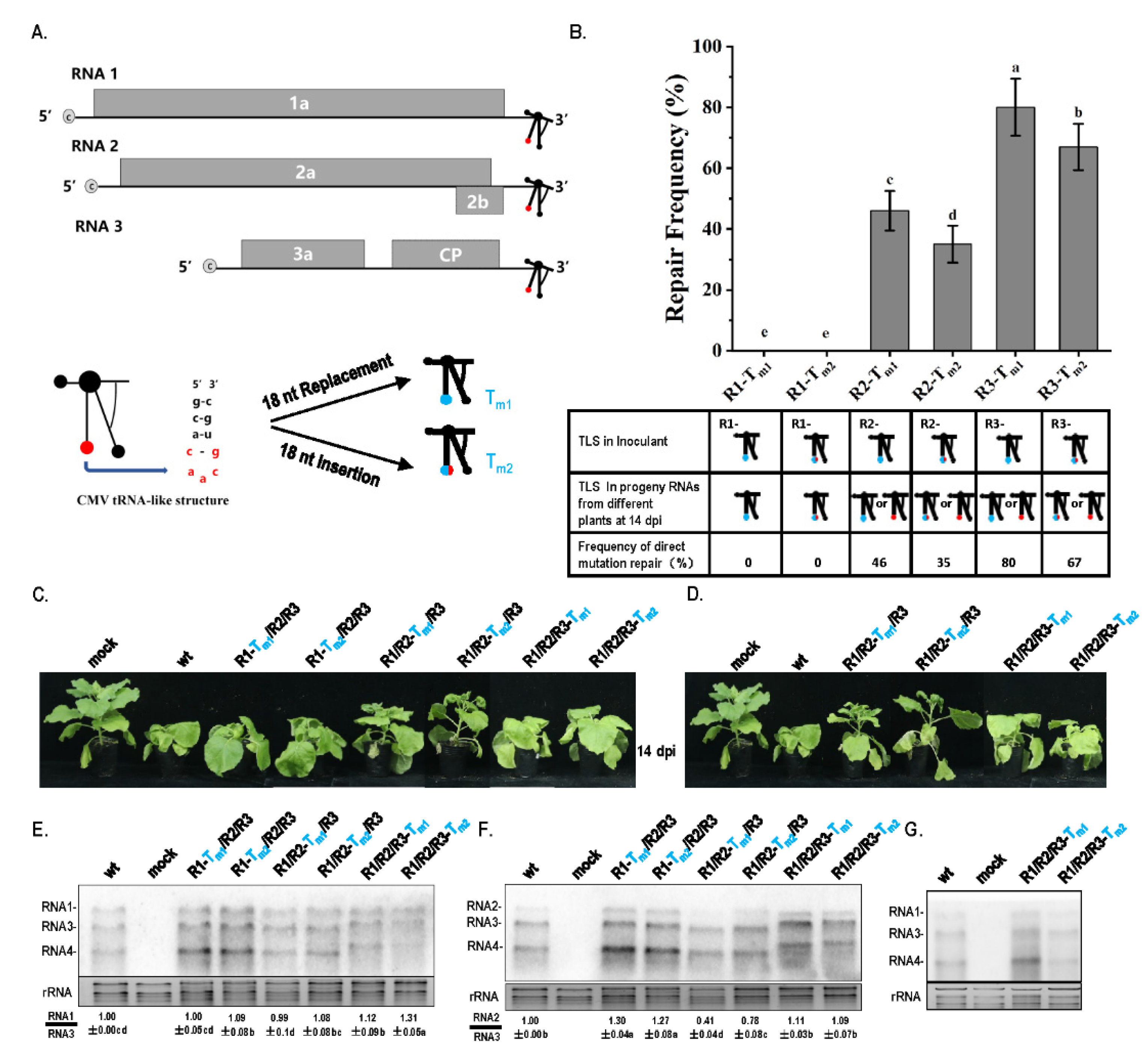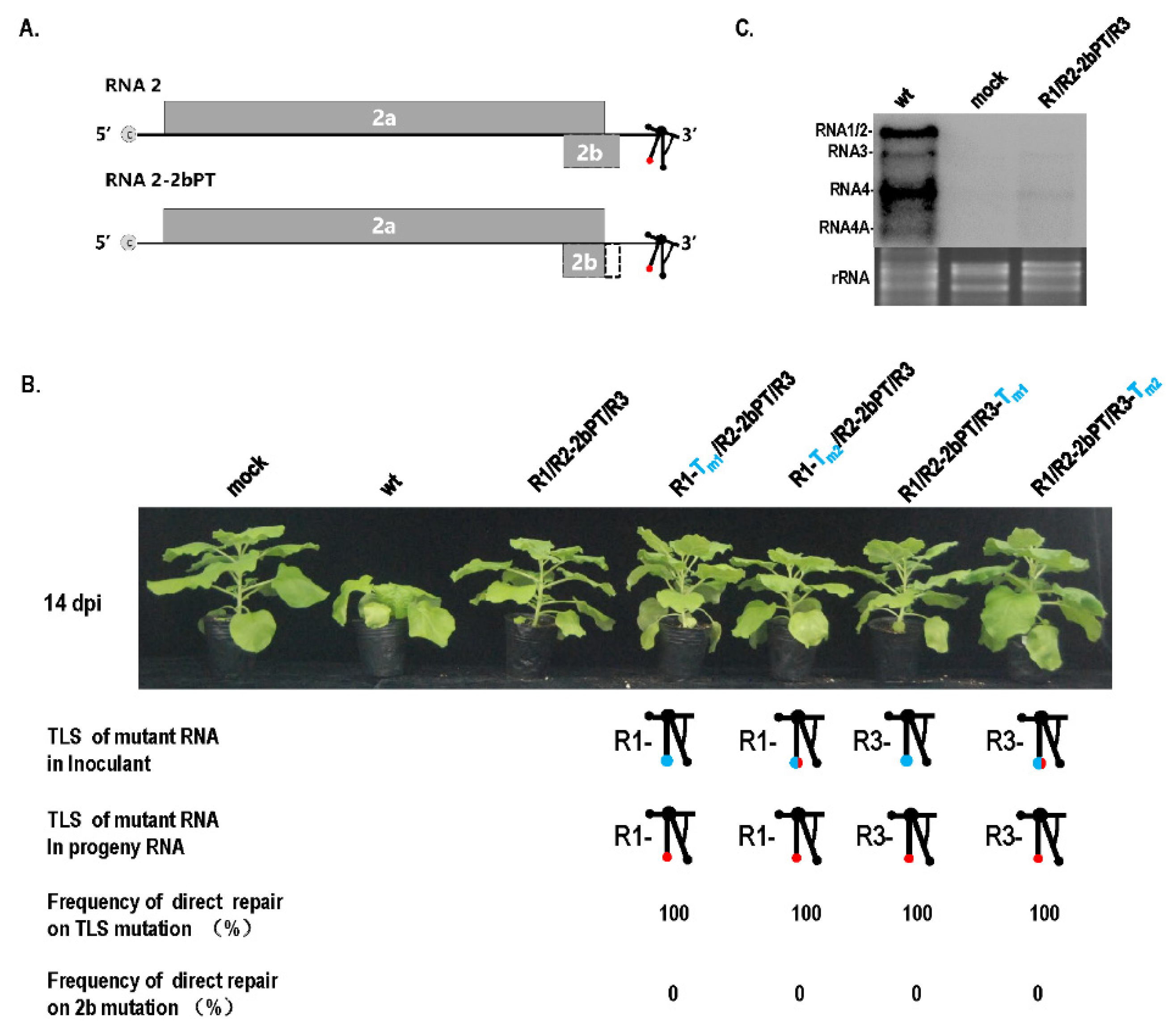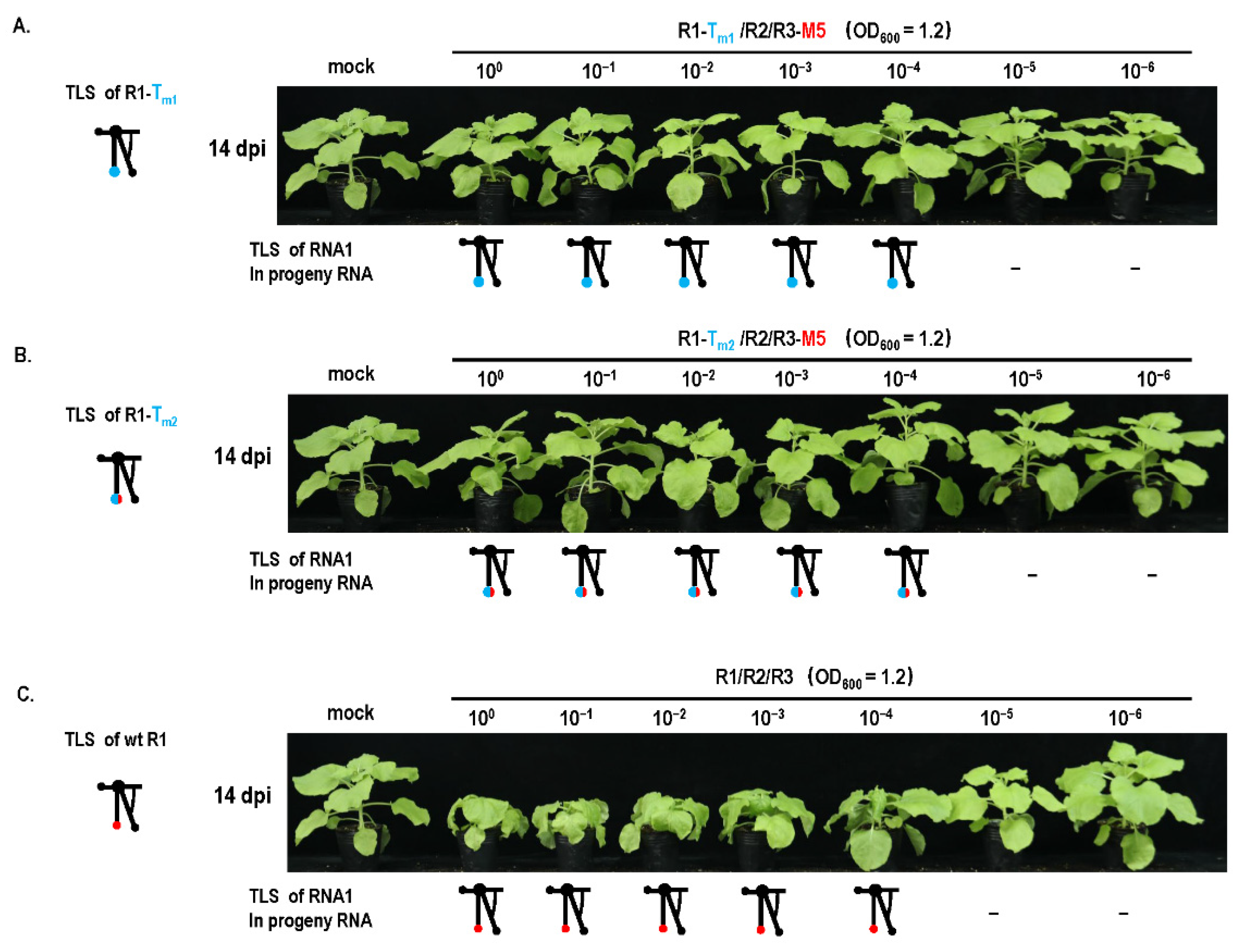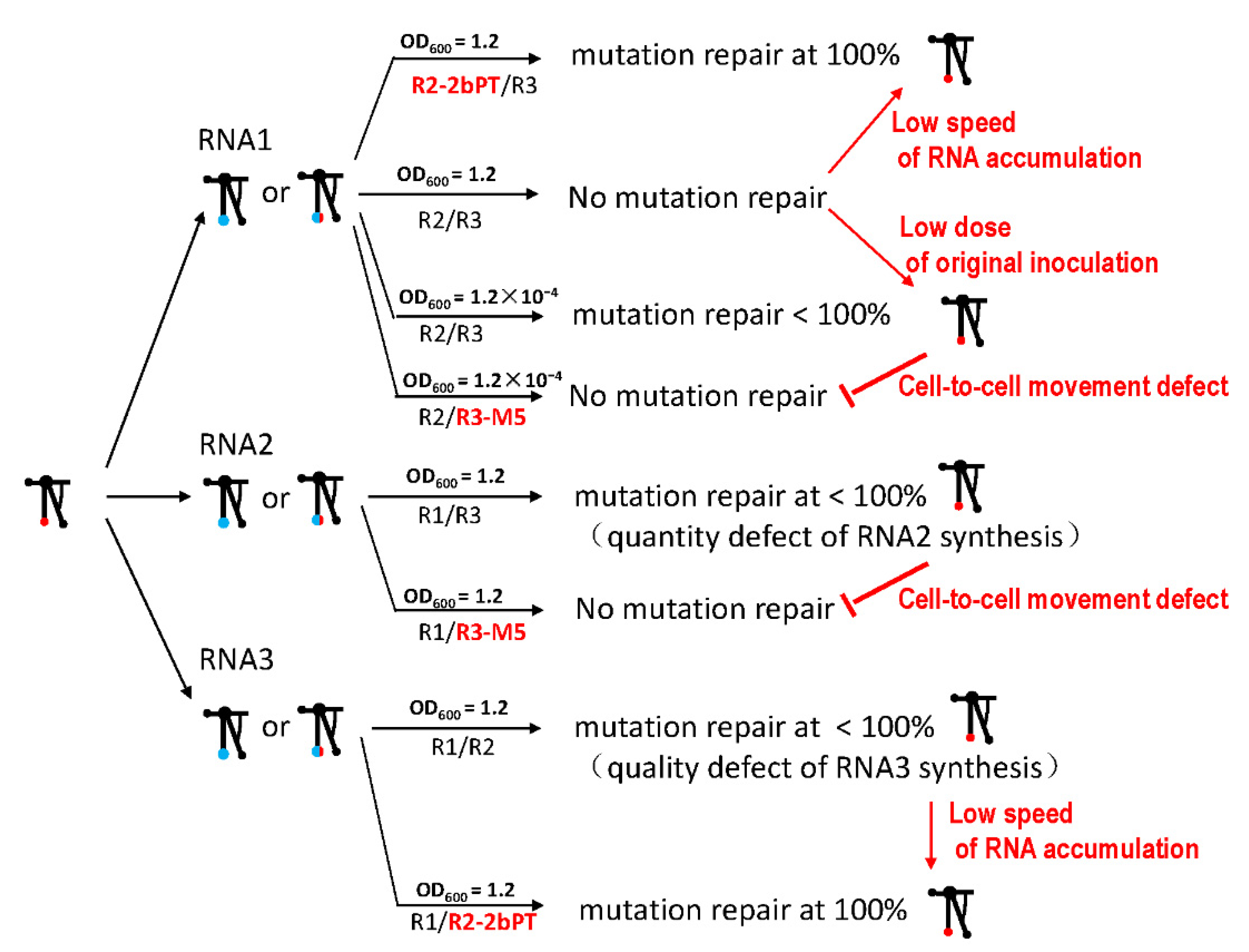Multiple Levels of Triggered Factors and the Obligated Requirement of Cell-to-Cell Movement in the Mutation Repair of Cucumber Mosaic Virus with Defects in the tRNA-like Structure
Abstract
:Simple Summary
Abstract
1. Introduction
2. Materials and Methods
2.1. Plasmid Construction
2.2. Plasmid Transformation and Agroinfiltration
2.3. Mutation Repair Assay
2.4. Northern Blot
2.5. Statistical Analysis
3. Results
3.1. TLS Mutation in Different RNAs of CMV Showed Remarkable Differences in Repair Frequency, Mediated by Copy-Choice-Type RNA Recombination
3.2. Quality or Quantity Defects of Genomic RNAs via TLS Mutation in RNA2 or RNA3 of CMV, Triggering the Repair Mechanism
3.3. Mutation Repair of Debilitating Genomes Could Be Triggered by Critical-Threshold Low Dose, Especially around Dilution End-Point
3.4. Cell-to-Cell Movement Was Required for TLS Mutation Repair
4. Discussion
4.1. Similar TLS Elements in Different RNAs of CMV Play Different Roles in CMV Pathogenicity
4.2. Multiple Levels of Factors Can Trigger Mutation Repair
4.3. Cell-to-Cell Movement Is Obligatory for Mutation Repair
4.4. Revelation on Construction and the Application of Mild Vaccines from Mutation Repair
5. Conclusions
Supplementary Materials
Author Contributions
Funding
Institutional Review Board Statement
Informed Consent Statement
Data Availability Statement
Acknowledgments
Conflicts of Interest
References
- Agol, V.I. Vaccine-derived polioviruses. Biologicals 2006, 34, 103–108. [Google Scholar] [CrossRef] [PubMed]
- Barr, J.N.; Fearns, R. How RNA viruses maintain their genome integrity. J. Gen. Virol. 2010, 91, 1373–1387. [Google Scholar] [CrossRef]
- Agol, V.I.; Gmyl, A.P. Emergency services of viral RNAs: Repair and remodeling. Microbiol. Mol. Biol. Rev. 2018, 82, e00067-17. [Google Scholar] [CrossRef] [PubMed] [Green Version]
- Sztuba-Solińska, J.; Urbanowicz, A.; Figlerowicz, M.; Bujarski, J.J. RNA-RNA recombination in plant virus replication and evolution. Annu. Rev. Phytopathol. 2011, 49, 415–443. [Google Scholar] [CrossRef] [PubMed]
- Mueller, S.; Papamichail, D.; Coleman, J.R.; Skiena, S.; Wimmer, E. Reduction of the rate of poliovirus protein synthesis through large-scale codon deoptimization causes attenuation of viral virulence by lowering specific infectivity. J. Virol. 2006, 80, 9687–9696. [Google Scholar] [CrossRef] [PubMed] [Green Version]
- Prostova, M.A.; Gmyl, A.P.; Bakhmutov, D.V.; Shishova, A.A.; Khitrina, E.V.; Kolesnikova, M.S.; Serebryakova, M.V.; Isaeva, O.V.; Agol, V.I. Mutational robustness and resilience of a replicative cis-element of RNA virus: Promiscuity, limitations, relevance. RNA Biol. 2015, 12, 1338–1354. [Google Scholar] [CrossRef] [PubMed] [Green Version]
- Jaag, H.M.; Stork, J.; Nagy, P.D. Host transcription factor Rpb11p affects tombusvirus replication and recombination via regulating the accumulation of viral replication proteins. Virology 2007, 368, 388–404. [Google Scholar] [CrossRef] [Green Version]
- Kirkegaard, K.; Baltimore, D. The mechanism of RNA recombination in poliovirus. Cell 1986, 47, 433–443. [Google Scholar] [CrossRef]
- Muslin, C.; Kain, A.M.; Bessaud, M. Recombination enteroviruses, a multi-step modular evolutionary process. Viruses 2019, 11, 859. [Google Scholar] [CrossRef] [Green Version]
- Chetverin, A.B.; Chetverina, H.V.; Demidenko, A.A.; Ugarov, V.I. Nonhomologous RNA recombination in a cell-free system: Evidence for a transesterification mechanism guided by secondary structure. Cell 1997, 88, 503–513. [Google Scholar] [CrossRef] [Green Version]
- Nagy, P.D.; Zhang, C.; Simon, A.E. Dissecting RNA recombination in vitro: Role of RNA sequences and the viral replicase. EMBO J. 1998, 17, 2392–2403. [Google Scholar] [CrossRef]
- Galleiet, A.; Pankraz, A.; Thiel, H.J.; Becher, P. RNA recombination in vivo in the absence of viral replication. J. Virol. 2004, 78, 6271–6281. [Google Scholar] [CrossRef] [Green Version]
- Gmyl, A.P.; Agol, V.I. Diverse mechanisms of RNA recombination. Mol. Biol. 2005, 39, 529–542. [Google Scholar] [CrossRef]
- Figlerowicz, M.; Nagy, P.D. A mutation in the putative RNA polymerase gene inhibits nonhomologous, but not homologous, genetic recombination in an RNA virus. Proc. Natl. Acad. Sci. USA 1997, 94, 2073–2078. [Google Scholar] [CrossRef] [Green Version]
- Baird, H.A.; Galetto, R.; Yong, G. Sequence determinants of breakpoint location during HIV-1 intersubtype recombination. Nucleic Acids Res. 2006, 34, 5203–5216. [Google Scholar] [CrossRef]
- Prasanth, K.R.; Kovalev, N.; Decastro, M. Screening a yeast library of temperature-sensitive mutants reveals a role for actin in tombusvirus RNA recombination. Virology 2016, 489, 233–242. [Google Scholar] [CrossRef] [Green Version]
- Kovalev, N.; Pogany, J.; Nagy, P.D. Interviral recombination between plant, insect and fungal RNA viruses: The role of intracellular Ca2+/ Mn2+ pump. J. Virol. 2019, 94, e01015-19. [Google Scholar] [CrossRef]
- Ouedraogo, R.S.; Pita, J.S.; Somda, I.P.; Traore, O.; Roossinck, M.J. Impact of Cultivated Hosts on the Recombination of Cucumber Mosaic Virus. J. Virol. 2019, 93, e01770-18. [Google Scholar] [CrossRef] [Green Version]
- Pita, J.S.; Morris, V.; Roossinck, M.J. Mutation and recombination frequencies reveal a biological contrast within strains of Cucumber mosaic virus. J. Virol. 2015, 89, 6817–6823. [Google Scholar] [CrossRef] [Green Version]
- Mochizuki, T.; Ohki, S.T. Cucumber mosaic virus: Viral genes as virulence determinants. Mol. Plant Pathol. 2012, 13, 217–225. [Google Scholar] [CrossRef]
- Sivakumaran, K.; Bao, Y.; Roossinck, M.J.; Kao, C.C. Recognition of the core RNA promoter for minus-strand RNA synthesis by the replicases of brome mosaic virus and cucumber mosaic virus. J. Virol. 2000, 74, 10323–10331. [Google Scholar] [CrossRef] [Green Version]
- Yao, M.; Zhang, T.; Tian, Z.; Wang, Y.; Tao, X. Construction of agrobacterium-mediated cucumber mosaic virus infectious cDNA clones and 2b deletion viral vector. Sci. Agric. Sin. 2011, 44, 3060–3068. (In Chinese) [Google Scholar] [CrossRef]
- Ding, B.; Li, Q.; Nguyen, L.; Palukaitis, P.; Lucas, W.J. Cucumber mosaic virus 3a protein potentiates cell-to-cell trafficking of CMV RNA in tobacco plants. Virology 1995, 207, 345–353. [Google Scholar] [CrossRef] [PubMed] [Green Version]
- Geng, G.; Yu, C.; Li, X.; Yuan, X. A unique internal ribosome entry site representing a dynamic equilibrium state of RNA tertiary structure in the 5’-UTR of Wheat yellow mosaic virus RNA1. Nucleic Acids Res. 2020, 48, 390–404. [Google Scholar] [CrossRef] [PubMed]
- Weigel, D.; Glazebrook, J. Transformation of agrobacterium using the freeze-thaw method. CSH Protoc. 2006, 2006, pdb.prot4666. [Google Scholar] [CrossRef]
- Cao, X.; Liu, S.; Yu, C.; Li, X.; Yuan, X. A new strategy of using satellite RNA to control viral plant diseases: Post-inoculation with satellite RNA attenuates symptoms derived from pre-infection with its helper virus. Plant Biotechnol. J. 2019, 17, 1856–1858. [Google Scholar] [CrossRef] [PubMed]
- Yuan, X.; Cao, Y.; Xi, D.; Guo, L.; Han, C.; Li, D.; Zhai, Y.; Yu, J. Analysis of the subgenomic RNAs and the small open reading frames of beet black scorch virus. J. Gen. Virol. 2006, 87, 3077–3086. [Google Scholar] [CrossRef]
- Yuan, X.; Shi, K.; Young, M.Y.L.; Simon, A.E. The terminal loop of a 3’proximal hairpin plays a critical role in replication and the structure of the 3’region of turnip crinkle virus. Virology 2010, 402, 271–280. [Google Scholar] [CrossRef] [Green Version]
- Boccard, F.; Baulcombe, D. Mutational analysis of cis-acting sequences and gene function in RNA3 of cucumber mosaic virus. Virology 1993, 193, 563–578. [Google Scholar] [CrossRef]
- Chapman, M.R.; Rao, A.L.N.; Kao, C.C. Sequences 5’ of the conserved tRNA-like promoter modulate the initiation of minus-strand synthesis by the brome mosaic virus RNA-dependent RNA polymerase. Virology 1998, 252, 458–467. [Google Scholar] [CrossRef] [Green Version]
- Dreher, T.W. Role of tRNA-like structures in controlling plant virus replication. Virus Res. 2009, 139, 217–229. [Google Scholar] [CrossRef] [Green Version]
- Rao, A.L.N.; Kao, C.C. The brome mosaic virus 3’untranslated sequence regulates RNA replication, recombination, and virion assembly. Virus Res. 2015, 206, 46–52. [Google Scholar] [CrossRef] [Green Version]
- Cooper, P.D. A genetic map of poliovirus temperature-sensitive mutants. Virology 1968, 35, 584–596. [Google Scholar] [CrossRef]
- Deffit, S.N.; Hundley, H.A. To edit or not to edit: Regulation of ADAR editing specificity and efficiency. Wiley Interdiscip. Rev. RNA 2016, 7, 113–127. [Google Scholar] [CrossRef]
- Neme, R.; Amador, C.; Yildirim, B.; McConnell, E.; Tautz, D. Random sequences are an abundant source of bioactive RNAs or peptides. Nat. Ecol. Evol. 2017, 1, 0217. [Google Scholar] [CrossRef]
- Shirogane, Y.; Watanabe, S.; Yanagi, Y. Cooperation: Another mechanism of viral evolution. Trends Microbiol. 2013, 21, 320–324. [Google Scholar] [CrossRef]
- Bujarski, J.J.; Kaesberg, P. Genetic recombination between RNA components of a multipartite plant virus. Nature 1986, 321, 528–531. [Google Scholar] [CrossRef]
- Rao, A.L.N.; Dreher, T.W.; Marsh, L.E.; Hall, T.C. Telomeric function of the tRNA-like structure of brome mosaic virus RNA. Proc. Natl. Acad. Sci. USA 1989, 86, 5335–5339. [Google Scholar] [CrossRef] [Green Version]
- Hema, M.; Gopinath, K.; Kao, C. Repair of the tRNA-like CCA sequence in a multipartite positive-strand RNA virus. J. Virol. 2005, 79, 1417–1427. [Google Scholar] [CrossRef] [Green Version]
- Rao, A. Sensitivity of brome mosaic virus RNA1 replication to mutations in the 3’ tRNA-like structure implies a requirement for sustained synthesis of replicase protein 1a. Arch. Virol. 2006, 151, 721–733. [Google Scholar] [CrossRef]
- Chao, L. Fitness of RNA virus decreased by Muller’s ratchet. Nature 1990, 348, 454–455. [Google Scholar] [CrossRef]
- Duarte, E.; Clarke, D.; Moya, A.; Domingo, E.; Holland, J. Rapid fitness losses in mammalian RNA virus clones due to Muller’s ratchet. Proc. Natl. Acad. Sci. USA 1992, 89, 6015–6019. [Google Scholar] [CrossRef] [Green Version]
- Yuste, E.; Sánchez-Palomino, S.; Casado, C.; Domingo, E.; López-Galíndez, C. Drastic fitness loss in human immunodeficiency virus type 1 upon serial bottleneck events. J. Virol. 1999, 73, 2745–2751. [Google Scholar] [CrossRef] [Green Version]
- Lázaro, E.; Escarmís, C.; Pérez-Mercader, J.; Manrubia, S.C.; Domingo, E. Resistance of virus to extinction on bottleneck passages: Study of a decaying and fluctuating pattern of fitness loss. Proc. Natl. Acad. Sci. USA 2003, 100, 10830–10835. [Google Scholar] [CrossRef] [Green Version]
- de la Iglesia, F.; Elena, S.F. Fitness declines in tobacco etch virus upon serial bottleneck transfers. J. Virol. 2007, 81, 4941–4947. [Google Scholar] [CrossRef] [Green Version]
- Jaramillo, N.; Domingo, E.; Muñoz-Egea, M.C.; Tabarés, E.; Gadea, I. Evidence of Muller’s ratchet in herpes simplex virus type 1. J. Gen. Virol. 2013, 94, 366–375. [Google Scholar] [CrossRef]
- Manrubia, S.C.; Escarmís, C.; Domingo, E.; Lázaro, E. High mutation rates, bottlenecks, and robustness of RNA viral quasispecies. Gene 2005, 347, 273–282. [Google Scholar] [CrossRef]
- Zwart, M.P.; Elena, S.F. Matters of size: Genetic bottlenecks in virus infection and their potential impact on evolution. Annu. Rev. Virol. 2015, 2, 161–179. [Google Scholar] [CrossRef]
- Poirier, E.Z.; Vignuzzi, M. Virus population dynamics during infection. Curr. Opin. Virol. 2017, 23, 82–87. [Google Scholar] [CrossRef]
- Huang, S.; Huang, Y.; Tsai, H.; Kuo, P.; Wang, S.; Liu, C.; Wang, J. A selective bottleneck shapes the evolutionary mutant spectra of enterovirus A71 during viral dissemination in humans. J. Virol. 2017, 91, e01062-17. [Google Scholar] [CrossRef] [Green Version]
- Clarke, D.K.; Duarte, E.A.; Moya, A.; Elena, S.F.; Domingo, E.; Holland, J. Genetic bottlenecks and population passages cause profound fitness differences in RNA viruses. J. Virol. 1993, 67, 222–228. [Google Scholar] [CrossRef] [PubMed] [Green Version]
- Escarmís, C.; Lázaro, E.; Manrubia, S.C. Population bottlenecks in quasispecies dynamics. Curr. Top. Microbiol. Immunol. 2006, 299, 141–170. [Google Scholar] [CrossRef]
- Escarmís, C.; Perales, C.; Domingo, E. Biological effect of Muller’s ratchet: Distant capsid site can affect picornavirus protein processing. J. Virol. 2009, 83, 6748–6756. [Google Scholar] [CrossRef] [PubMed] [Green Version]
- Zwart, M.P.; Erro, E.; van Oers, M.M.; de Visser, J.A.G.M.; Vlak, J.M. Low multiplicity of infection in vivo results in purifying selection against baculovirus deletion mutants. J. Gen. Virol. 2008, 89, 1220–1224. [Google Scholar] [CrossRef] [PubMed]
- Wright, S. The roles of mutation, inbreeding, crossbreeding and selection in evolution. Sixth Int. Congr. Genet. 1932, 1, 356–366. [Google Scholar]
- Elena, S.F.; Solé, R.V.; Sardanyés, J. Simple genomes, complex interactions: Epistasis in RNA virus. Chaos 2010, 20, 026106. [Google Scholar] [CrossRef] [PubMed] [Green Version]
- Lalić, J.; Elena, S.F. Magnitude and sign epistasis among deleterious mutations in a positive-sense plant RNA virus. Heredity 2012, 109, 71–77. [Google Scholar] [CrossRef] [Green Version]
- Silva, J.D.; Wyatt, S.K. Fitness valleys constrain HIV-1’s adaptation to its secondary chemokine coreceptor. J. Evol. Biol. 2014, 27, 604–615. [Google Scholar] [CrossRef]
- Ziebell, H.; Carr, J.P. Cross-protection: A century of mystery. Adv. Virus Res. 2010, 76, 211–264. [Google Scholar] [CrossRef]
- Hasiów-Jaroszewska, B.; Borodynko, N.; Jackowiak, P.; Figlerowicz, M.; Pospieszny, H. Single mutation converts mild pathotype of the Pepino mosaic virus into necrotic one. Virus Res. 2011, 159, 57–61. [Google Scholar] [CrossRef]
- Ziebell, H.; MacDiarmid, R. Prospects for engineering and improvement of cross-protective virus strains. Curr. Opin. Virol. 2017, 26, 8–14. [Google Scholar] [CrossRef]








Publisher’s Note: MDPI stays neutral with regard to jurisdictional claims in published maps and institutional affiliations. |
© 2022 by the authors. Licensee MDPI, Basel, Switzerland. This article is an open access article distributed under the terms and conditions of the Creative Commons Attribution (CC BY) license (https://creativecommons.org/licenses/by/4.0/).
Share and Cite
Liu, S.; Mu, J.; Yu, C.; Geng, G.; Su, C.; Yuan, X. Multiple Levels of Triggered Factors and the Obligated Requirement of Cell-to-Cell Movement in the Mutation Repair of Cucumber Mosaic Virus with Defects in the tRNA-like Structure. Biology 2022, 11, 1051. https://doi.org/10.3390/biology11071051
Liu S, Mu J, Yu C, Geng G, Su C, Yuan X. Multiple Levels of Triggered Factors and the Obligated Requirement of Cell-to-Cell Movement in the Mutation Repair of Cucumber Mosaic Virus with Defects in the tRNA-like Structure. Biology. 2022; 11(7):1051. https://doi.org/10.3390/biology11071051
Chicago/Turabian StyleLiu, Shanshan, Jinze Mu, Chengming Yu, Guowei Geng, Chenyu Su, and Xuefeng Yuan. 2022. "Multiple Levels of Triggered Factors and the Obligated Requirement of Cell-to-Cell Movement in the Mutation Repair of Cucumber Mosaic Virus with Defects in the tRNA-like Structure" Biology 11, no. 7: 1051. https://doi.org/10.3390/biology11071051





